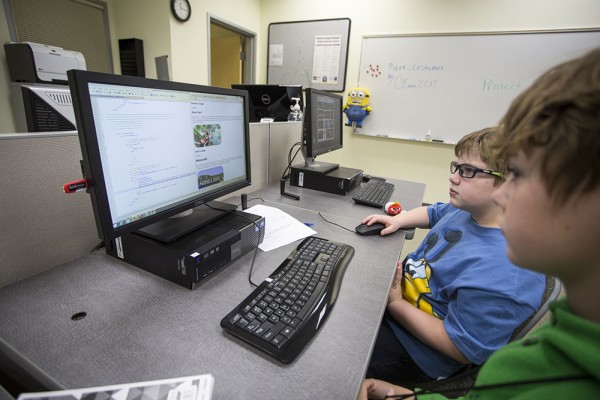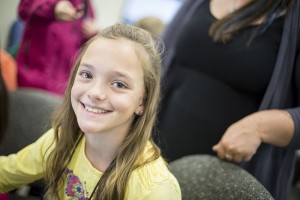UAA Kids' College summer coding camp lures eager kids
by Tracy Kalytiak |
Network protocol stacks. Binary trees. Recursive flood fill algorithms.

Alex Lehman, left, and Simon Mitchell work on one of their projects during the creative coding class at UAA Continuing Education's Kids' College. (Photo by Theodore Kincaid/University of Alaska Anchorage)
The terms are just a sampling of the programming patois Simon Mitchell and Alex Lehman might someday fold into their coding vocabularies.
But not just yet. The two 10-year-old students enrolled in the creating coding class offered at UAA's Kids' College were completely absorbed in devising a virtual bat that could fly around and shoot at a virtual target.
"Once we got everything done I was like, OK, you have to close your eyes for this because I wanted to do something so obnoxious he would hate me for it," Alex cackled mischievously. He then pointed at the target on the screen. "I made it invisible. Well, it's not invisible. It's this little black dot but it's the size of, like, a pixel. Now he can't even score a point on me. Now come at me, bro!"
Enhancing technical competence
Kids' College, a summer camp component of the Community & Technical College's continuing education department, offers children between the ages of 8-10 and 11-15 the opportunity to plunge into week-long sessions immersing them in: • Basics of HTML, JavaScript and CSS web coding languages. • How to design 3-D models for Minecraft games. • How to create mobile apps and games. • How to craft a graphic novel. • How to make videogames.
The cost for kids registering now for the scarce remaining spots is $179 for a session of five half-days. The cost had been $339 for two half-day sessions for each of five weekdays, which includes lunch, but those slots are no longer open.
"This is the first time we ran this curriculum," Emily DaLuz, the program's marketing coordinator, said of Black Rocket, a company that offers a variety of creative science and other programs aimed at children and young adults. "It's amazing to me, teaching these kids, what they already know!" Then, she said, joking: "It wasn't until high school that I even knew what coding was!"
The six weeks of Kids' College class sessions began in late June but Dana Thorp Patterson, director of Continuing Education, said the Kids' College classes were advertised in January with early-bird registration offers.
"They have proven to be enormously popular, with every class filled to capacity and a wait list for more sections," Patterson said. "The success of these classes indicates Alaska youths and their parents are eager for technology courses that enhance creativity, technical thinking, eye-hand coordination, and social interaction." Patterson also noted that the summer program's more than 260 enrollments have led Continuing Education to schedule more of these courses throughout the year, running a Saturday series and spring break camp.
Learning through games
One of the instructors, Dr. Seong Dae Kim, usually teaches College of Engineering graduate students the intricacies of project management. Teaching creative coding to kids less than half their age proved to be challenging, in an inspiring way, he said. "They're amazing," he said of the 8- to 10-year-olds enrolled in his class. "They're self-motivated even though they're young for this type of course."
Kim taught the kids with the help of Notepad++ and BYOB software and code.org and codecombat.com websites.
"Instead of typing all the code, we used drag-and-drop code and made a very simple game," Kim said. "Now they're using Notepad++ to code a webpage. They pick their own topic and do a project for the week."
Several of the children-like Simon and Alex, whose parents are, respectively, engineers and programmers-either have been exposed to coding or have learned a little about writing it. Others in his class, Kim said, are much less experienced.
"Some didn't know how to turn on a computer, how to use a web browser, what a web browser was," he said.
Kalima Glascott is a student whose computer skills are situated somewhere in between.

Kalima Glascott, 9, is one of the students in the creative coding class at UAA Kids' College this summer. (Photo by Theodore Kincaid/University of Alaska Anchorage)
Her mother saw a flier about Kids' College at Government Hill Spanish Immersion School.
"She said I'd learn a lot about computers, what's involved, how to make apps, how to digital storytell and also coding," the 9-year-old said. "It involved codes and numbers and words, something that was new to me."
The likeness of the Mona Lisa adorned Kalima's budding website. "My topic is art," she said, before gesturing toward a girl next to her, her class partner. "She has puppies because her topic is animals."
Kalima said Kim showed them how to use BYOB software and asked them to use what he taught to make a virtual bird land on a virtual rock. "To teach us about motion and control," Kalima said.
She and her partner-like Simon and Alex-devised a game. In the girls' game, Superman shot fireballs at Syndrome, while Syndrome shot lightning. "Syndrome is going to move up and down," Kalima said, "while Superman can move in all different directions. We're thinking we'll add obstacles to the Superman game."
Kalima deftly moved around blocks of code on her computer screen, showing the different effects that had on the sounds, movements and appearance of the game components and characters.
"Now I know how to be able to code," Kalima said. "I want to take another class, learn different things. This was fun!"
Written by Tracy Kalytiak, UAA Office of University Advancement
 "UAA Kids' College summer coding camp lures eager kids " is licensed under a Creative Commons Attribution-NonCommercial 4.0 International License.
"UAA Kids' College summer coding camp lures eager kids " is licensed under a Creative Commons Attribution-NonCommercial 4.0 International License.














